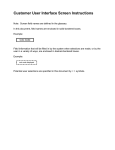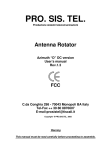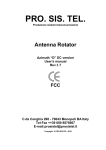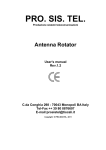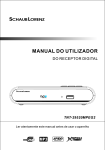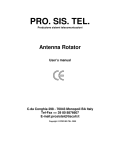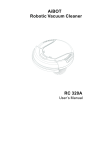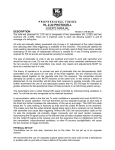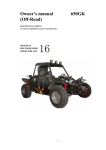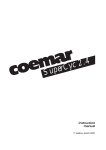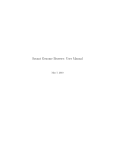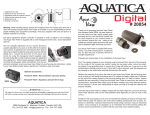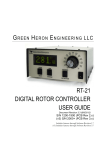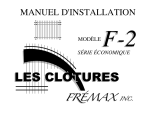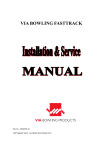Download Prosistel Rotator User`s Manual D Elevation
Transcript
PRO. SIS. TEL. Produzione sistemi telecomunicazioni Antenna Rotator Elevation “D” DC version User’s manual Rev.1 C.da Conghia 298 - 70043 Monopoli BA Italy Tel-Fax ++ 39 80 8876607 E-mail:[email protected] Copyright @ PRO.SIS.TEL. 2004 Warning This manual must be read carefully before proceeding to assembly. Warranty 1) The rotator with the control box, hereinafter called “product”, or “rotator”, is warranted for 2 years from date of purchase, provided that it is supported by the document of sale issued by the manufacturer or authorized distributor. 2) The warranty covers replacement or repair of any defective component. 3) This warranty does not apply to product which have been subjected to misuse, negligence, accident, incorrect wiring performed by the user, improper installation or non-compliance to instructions furnished by us, damage to product which has been repaired or altered without authorization or to injury or loss resulting from careless maintenance. The warranty does not cover damage due to transportation and all causes not arising from defects in workmanship. 4) The warranty does not cover costs of transport or insurance for material returned to our workshops. 5) The manufacturer is not responsible for personal injury or property damage resulting from improper or careless use of the product. 6) All product is tested after assembly and is supplied without defect. We exclude the substitution or the prolongation of warranty for a possible damage. 7) After the 2 years warranty period, maintenance or repair will be subject to parts and labor charges. 8) No person is authorized to assume for us any liability in connection with the sale of our products. 9) This warranty does not cover damage to people or things due to misuse, improper or careless installation, or misunderstanding of instructions furnished by us. 10) The right of recession must be exercised in according to the law. 11) Our products are subject to continuous improvement. We reserve the right to implement improvements and changes without prior notification. 12) The legal code applying in MONOPOLI, Italy, will apply, in cases of dispute. 13) Purchasers of product are deemed to accept paragraphs 1, 2, 3, 4, 5, 6, 7, 8, 9, 10, 11, 12 and 13 as above. Model: PST S/N: Date of purchase: 2 Important Read this instruction manual carefully before attempting to operate the antenna rotator. Save this instruction manual. This instruction manual contains important safety and operating instruction for antenna rotator. Precautions ! WARNING, never connect or disconnect rotor cable or RS232 connectors while power is on. This may results in electrical shock or burn. Table of contents Section 1: Description; Section 2: Installation and use; Section 3: Principle of operation ; Section 4: Technical specifications; Section 5: RS232 remote control philosophy; Table: Note: 3 Section 1 The controller “D” version 1-1 Front panels description. 1 - POWER SWITCH (POWER) Turns power ON and OFF 2 – Right lever: CW – UP momentarily switch Push and hold this switch will activate the rotator clock wise rotation. Push momentarily while the rotator is running, will stop the rotation. 3 – Left Lever: CCW - DOWN momentarily switch Push and hold this switch will activate the rotator counter clock wise rotation. Push momentarily while the rotator is running, will stop the rotation. 4 - Display Three digit, 7 led bars, will show the rotator degrees bearing. When turn preset knob, display will show the preset bearing. The decimal points on the LED display blink when: • you turn the target position knob on the front panel • rotation begins and is in progress • after the end of rotation, while the software waits the programmed time before allowing a new rotation (if you are using the CW/CCW keys, such a wait time is zero for successive rotations in the same direction) 5 - Preset rotating encoder Enables to preset a wanted bearing, just turns the knob, the display will switch on preset function and will show the encoder position, when the wanted bearing is reach, leaves the knob and after 3 second the rotor will automatically start and turn to the preset value, as the rotator start, the display will show the actually rotator bearing. “Err” is displayed when you turn the target position knob on the front panel to an angle outside the rotation limits. 4 1-2 Rear panels description. 1 - DB9, RS232 female connector Enables connectio to a personal computer RS232 serial port, for rotator’s remote operations. Pin 5 = computer ground Pin 2 = serial data out (to computer data in) Pin 3 = serial data in (from computer data out) 2 - Rotator control cable male connector. Connects the rotator external unit with the controller. 3 – AC Power male socket (230Vac or 115 Vac) Accept 230Vac or 115Vac throught the AC power cable (check the house’s power before to connect) 4 – Fuse holder. 19x5mm, 1.6A fuse is required. 1-3 “D” Controller features. Warning: this is a complex controller, be sure that all functions are well understood before to use it. This controller has several features settable via RS232 and some of such features are even settable manually. Four on board dip-switch allows manual selections. Controller parameters settable in either modes: • Soft start – Soft stop • South stop or North stop • Rotation range 360 or 500 (not used in elevation version) • Calibration • Off-set Controller parameters settable via RS232 only: • Revers delay • Preset delay • PWM duty cycles • Rotation range (do not use in elevation version) • Optimizer (do not use in elevation version) • Rotor chk Controller display mode settable manually only: • Absolute or relative display mode. • Entering in Absolute mode The controller uses an ADC which accepts 0-5V voltages. The antenna position voltage readout is mapped to be inside the 0-5V range. In the absolute mode the display shows directly the rotator position expressed in absolute degrees: you read values from 0 to 500. In the other operational modes (north/south-stop) the absolute readings are converted into different angular position numbers, but only for input/display purposes: internally the program works with absolute angles. The absolute mode can be only entered turning-on the CBOX with the CW key pressed until the display shows a blinking “---“ (three minus): now you can release the key and the absolute mode is entered. You can move the motor using CW and CCW keys between the rotation limits. To exit from such a mode you must recycle CBOX power (forcing another mode by RS232 command isn’t effective). In the absolute mode the rotor can be only operated by the CW/CCW The absolute mode is usefull for CBOX calibration (see CALIBRATION paragraph). It is NOT recommended to turn big antennas which need to be started and stopped softly. 5 The bearing values in degree as shown by the display, are not absolute but relative, as show in the conversion tables: Vdc Deg. 000 110 east side outrange 070 180 S South stop absolute values 160 250 340 270 000 090 W N E South stop Vdc Deg. 000 290 west side outrange 070 000 S 500 240 west side outrange 430 000 S 500 070 east side outrange relative values North stop absolute values 160 250 340 090 180 270 W N E North stop 430 180 S relative values That mean when the Vdc coming from rotor potentiometer is 0V, the display will show 110 deg. when in South stop (default) and will show 290 deg. when in North stop. With an applied voltage of 2.50V the display will show 000 deg when in South stop and and 180 deg when in North stop, while with an applied voltage of 5V the display will show 240 deg. when in South stop and 070 deg. when in North stop. • The on-board dip-switch There is a on-board dip-switch that allows the user to control a bit the operating mode without the intervention of a personal computer. Remember that the dip-switch status is read only at power-up and copied into the EEPROM: you must recycle the power in order a dip-switch status changement becomes effective. There are four switches: • #1: select the source of the three following parameters: if ON the source is the other three switches status, otherwise the relative EEPROM contents modifiable through the W command • #2: operating mode: if ON is north-stop, otherwise is south-stop • #3: rotation range: if ON the rotation range is 0 to 500 absolute degrees, otherwise is 70 to 430 absolute degrees • #4: PWM: if ON the PWM is enabled, otherwise is disabled The above parameters (ENA_PWM, LOWLIM, UPLIM, MODE) are not modifiable by RS232 commands is the switch #1 is ON (dip-switch selected). LOWLIM and UPLIM change accordingly with the POS_OFFSET values. • Soft start and soft stop: A mosfet controlled PWM is provided, when included it allow to get a soft start and a soft motor stop. Default valoue: included. • South stop or North stop: Via RS232 or on board dip-switch, it’s possible to switch the display reading mode. Default valoue: South stop. • Rotation range 360 or 500: 500 degrees of rotation range are provided. Such wide rotating range include 70° of extra travel for each side. In some cases it’s necessary to reduce that rotor’s overrun. Two modes are provided: Manually with the on board dip-switch that allow to select between two limits 500 or 360 degrees. Via RS232, is possible to reduce the rotating range having 1degree step in the range 0-500 degree as well even the CCW and CW ends. Absolute valoues must to be entered iaw conversion tables. Default valoue: 0-500 Degrees azimuth, 0-90 elevation • Calibration Two on board trimmers are provided to calibrate the controller. If necessary, you can recalibrate your controller via RS232. See calibration procedure issue. 6 • Off-set If the initial antenna direction it’s not coincident with the geografic direction, you can fix it manually using an on board off-set trimmer as well via RS232. Default valoue: 0 • Revers delay A reverse delay time is provided to prevent rotor, antennas and tower stress in case of immediate reversing rotation sense. You can increase or reduce such delay time as you like in consideration of the antenna dimentions. Suggested/default time: 3 seconds. • Preset delay A preset delay time is provided, it allow you to change the preset valoue several time before than the rotor start automatically to reach the selected position. Suggested/default time: 3 seconds • PWM duty cycles When included PWM allow to have a soft starting ramp and a soft stopping ramp. • Rotation range This controller allow you to have 500 degrees of total rotor rotation range with 70 degrees of extra travel for each side. An on board dip switch allow you to choose between two rotations ranges, 0-500 degrees (default) or 0-360 degrees. Do not use in elevation version. • Optimizer When included, if you select a target with Preset knob or via Rs232, the CPU check the shortest way than will start the rotor following such way. Do not use in elevation version. • Rotor chk When included, if you select a target with Preset knob or via RS232, the CPU check the rotor feed back signal, if it is not like it have to be, the rotor will be automatically stopped within 5 seconds. • Controller internal view 7 • Calibration procedure. First-time calibration: It is made in factory. Whenever an realignment is required (using the on-board OFFSET trimmer): 1. Turn the antenna in a well known direction: if there is some disalignment the position readout differs from the expected one. 2. Regulate the on-board OFFSET trimmer until the readout reach the expected value 1.4 The rotator The rotor has a structure where a TV disc actuator is used as elevation motor. It push or pull an arm welded up a mast clamp having 90° of elevation range. Top cm 23 - 30 Tubular mast clamp Front side Back side cm 30 UP cm 67 cm 35 DOWN Rotor position on the vertical mast 30 cm or more TV disc jack Azimuth mast Bottom 8 Section 2 Installation and connections 2.1 Unpacking After unpacking, immediately report any damage to the delivering carrier or dealer. Keep the shipping cartoon. 2.2 Power supply connection Connect the power cable and switch power on, display will show PHH. Switch power OFF. 2.3 Rotator control cable preparation & connection Before installing the rotator inside a tower, you need to prepare male connector for remote control cable, make all connections and test rotator operation throughly on the ground, as described below. Connect the rotator and control box with a 5-core control cable. Two cores are used for the motor DC power supply, and three for the position reading potentiometer. If the diameter of the control cable is too thin, it will limit the voltage and reduce the torque. Do not use cable with less than 0.5 mm² of section area. Before connecting rotator and controller, make sure that power switch is OFF. Cable plug Wire no. 1 Wire no. 2 Wire no. 3 Wire no. 4 Wire no. 5 Motor terminals board must be connected to must be connected to must be connected to must be connected to must be connected to 1 (VDC motor power) >= 1mm² 2 (VDC motor power) >= 1mm² 3 (P to pot central lead) 4 (+5 Vdc pot lead) 5 (0 Vdc pot lead/GROUND) Warning: Improper wiring can result in damage to the rotator circuitry when the power is swiched on. THIS IS NOT COVERED BY THE WARRANTY. 2.4 Rotator cable inspection Carefully check that the rotator cable connections are as they should be before to connect the controller. To check the rotor cable you need a digital multimeter. Rotator cable true table (either valid for motor board and rotor control cable connector end). Pins 1 and 2 (internal DC motor resistence = ~ 19 ohm) Pin 1 and ground = open Pin 2 and ground = open Pin 3 and 5 = ~2K (mobile pot end and negative pot end) Pin 3 and 4 = ~8K (positive pot ends and mobile pot end) Pin 4 and 5 = 10K (pot ends) If you did not get such values, check the cable connections ends. 2.5 Preinstallation check ! Warning, use only CW and CCW switch while preinstallation check is in progress. Switch power ON, display will show PHH and after than the rotator position. Push the direction lever in CW sense and jack will push up the tubular clamp arm, the display will follow the rotation and will show increasing positive valoue in degrees. Revers the lever in CCW sense, and the jack will pull the tubular clamp arm. The display will follow the rotation and will show decreasing valoue. To become familiar with the rotor, do some test CW/UP and CCW/DOWN, ceck the travel limits, they should be: CCW/DOWN +- -000 and CW/UP +- 090. 9 2.6 Troubleshooting - Power - Check the presence of the house power at power outlet; - Check that the power cable plugs is correctly connected. - Check the fuse. If it’s blown, replace it with one of the correct value and switch power on. If it blows again, the user contacts the local service agent. - Motor turns in the wrong direction - If while you were pushing CW switch the rotator started in counter sense, than the motor is getting reversed DC power polarity. Exchange the wires between leads 1 and 2. - Rotator follow the right CW and CCW commands but display show the opposite. - With a digital voltmeter, check the presence of +5Vdc on the motor board, lead no. 4 If +5Vdc is not there, check the rotator cable connections/continuity. 2.7 Rotator installation Install the rotor up the azimuth mast, no less then 30cm or 1ft from the tower top. The front side is were motor is placed, while the back is were the azimuth mast is placed. Fit inside the tubular mast clamp the elevation mast, after when is centered and balanced in the both sides, lock it with the bolts. Turn the rotor up 000 and then procede to install the antennas. 2.8 Antenna direction adjustement Antenna rotator alignement is mechanical. See Calibration Offset issue. Small allignement errors can be corrected, turning the potentiometer case, bring antenna in horizontal position (000) than just release a little bit the metal belt, switch on the controller in absolute condition and turn the round potentiometer case to read 25.0, than tighten again the metal belt. Swicth off and on again the controller. 2.9 Rotator maintenance The worm-geared motors are lubrificated for life and no maintenance is required. If you live in an industrial zone or sea area, after a time you may have some corrosion to the outer casing. Rotators are coated with anticorrosive paint at the factory and if repainting is necessary, use ordinary anticorrosive paint for ferrous metal. 10 Section 3 Principles of operation 3.1 Electrical configuration 3.1.1 Indicator circuit Three digit, 7 segments led display are used for the direction indicator and the antenna direction is displayed in degrees. 3.1.2 Motor power switch The motor is powered throught two 10 Amps long life relais. AC FILTER POWER SUPPLY 115V 60Hz 0-42Vac 230V 50Hz 0-12Vac TRANSF 0-9Vac CPU INPUT 1 + DC MOTOR POWER M DISPLAY 2 - 4 +5VDC CW CCW ENCODER 3 P POT. GND RS232 PRO.SIS.TEL. C.da Conghia 298 70043 Monopoli BA tel.- fax ++39 80 8876607 www.prosistel.it DRAW: PST61DC, working basic block scheme S/N: A005 REV: 1 DRAWN BY: Capitanio Piero DATE: December, 15/2003 Note: All controllers have the same circuit board, and the same circuit drawing. Azimuth or elevation version depend only from software setup. 11 Section 4 Rotators Specifications CARATTERISTICHE METRICS PST75-12 PST75-18 PST75-24 Antenna wind area 1.2 m2 2.5 m2 4.5 m2 Elevation range 92° 92° 92° Static load 250Kg 460Kg 600kg Dinamic load 150Kg 250kg 300Kg Maximum mast diameter 53mm 53mm As request Rotore weight Kg 8 10 — US/UK CARATTERISTICHE PST75-12 PST75-18 PST75-24 Antenna wind area 12 sq.ft 25 sq.ft 45 sq.ft Elevation range 92° 92° 92° Static load 550 lbs 1000 lbs 1320 lbs Dinamic load 330 lbs 550 lbs 660 lbs Maximum mast diameter 2.5 inchs 2.5 inch As request Rotor weight lbs 17 22 __ 12 Section 5 RS232 computer control philosofy With this user’s manual a diskette is provided. In such diskette you will get as follow: • RS232 philosofy.pdf This file contain extensive informations and instructions about the RS232 computer control philosofy and more information about the controller features larger than of what is included in this printed manual. Please read it carefully. • RotorVxxx.exe (tool software) This is an executable software that allow you to change your rotor parameters as well you like it. Such program have to be intended as a tool and not as a remote control program. You must be extremly carefully using it and before to do any operation be sure to know what you are doing. • RotorVxxxReadme.pdf This file contain extensive information and instruction about the use of the “RotorVxxx.exe” tool software. Please read it carefully. Dear custmer, thank you for purchase a Pro.Sis.Tel./BigBoyRotators, if you are happy with it please talk to everybody, if you are unhappy with it please talk with us. Your feed back and suggestions, will be very appreciated, to improve our products. Annamaria Fiume IK7MWR MADE IN ITALY 13













